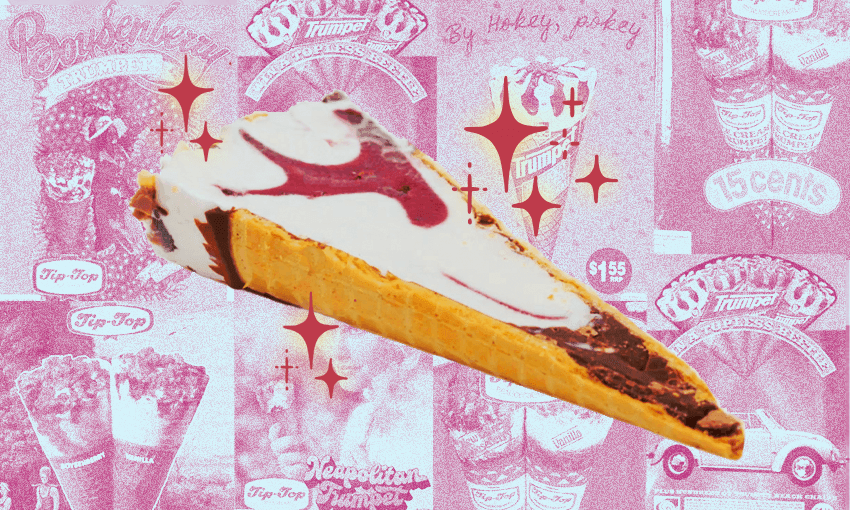Alex Casey uncovers the story behind that perfect final bite.
This is an excerpt from our weekly food newsletter, The Boil Up.
In the first episode of Snackmasters NZ, in which chefs Dariush Lolaiy and Ganesh Raj are challenged to recreate the boysenberry Trumpet, there’s one particular element that the Tip Top judges froth over. “Look at that plug, LOOK at that plug,” says one. “Great plug,” adds another, “the people love to see that.” The verdict is in for winner Lolaiy – “that is an A+ plug”.
This unsexy-sounding “plug” refers to the delicious morsel of hardened dark chocolate that greets the consumer at the end of any Trumpet cone. Indulging in a mint Trumpet this week in the name of science, I was left flabbergasted by the pure decadence and unparalleled generosity of this bonus treat-within-a-treat, and wanted to know how it came to be.
Ben Schurr, the CEO of Tip Top, was five years old when the Rachel Hunter Trumpet ad came out, and remembers it being one of the more “special” treats he was allowed as a kid. “The first time you have a Trumpet is just an amazing experience,” he says. “When you get to the end and there is that little chocolate tip… it just absolutely blows you away.”
Although it has now become one of the defining elements, Schurr tells me the chocolate tip was never part of the Trumpet plan. Back in the early 1960s, mass produced ice creams were mostly just ice cream and a cone, and manufacturers faced many issues with sogginess. “You can imagine everyone at the factory looking at the line and saying, how do we solve this problem?”
Tip Top would have already had around 50 tonnes of chocolate onsite to service the likes of the Choc Bar and the Jelly Tip dip, and Schurr says it would have made sense to spray it to the inside of the Trumpet cone to fight the dreaded sog. “Not only does it taste delicious but it also, crucially, creates that barrier between Mr. Cone and Mr. Ice Cream,” he explains.
It worked, but physics threw in another delicious curveball. “Even though our factory looks like Willy Wonka’s play pen, gravity is exactly the same here,” Schurr explains. To coat the entire inside of the cone as effectively as possible required a generous amount of chocolate spray, the excess of which settled to form a chocolate “plug” at the base of the cone.
“With technology being the way it was back then, the chocolate core was born because we didn’t really have a choice,” says Schurr. “What an amazing moment for the country.”
These days, the factory technology is much more sophisticated than in 1964, and Schurr says they could easily remove the chocolate tip. “If we were cone grinches, we could do it,” he threatens. “But then that would ruin the expectation of anybody that eats a Trumpet – it wouldn’t have that magic ending when you get to that little chocolate treat.”
Although beloved, the chocolate tip also appears to have had a Mandela effect on customers, who will frequently complain to Tip Top that it has both grown… and shrunk. “One of our hourly checks is to specifically look at the amount of chocolate spray and ensure that it’s the right viscosity, formulation and temperature to make the perfect size tip,” says Schurr.
“You would be amazed about the amount of hours that have been invested in New Zealand to get this absolutely perfect and consistent every single time.”
Thankfully, Schurr can say unequivocally that, even after 60 years, Trumpet’s chocolate tip isn’t going anywhere. “I think we’d be in big trouble,” he laughs. “I know it sounds like a life or death sort of thing, but it really is so important and I do take it really seriously.” Although the tip may be a mainstay, Schurr says there is always room for consumers to add their own personal flair.
“I do know some people out there eat the tip first, but I think it’s more an Australian thing where they do things a bit wrong,” he laughs. “And only once in my life have I seen someone eat a whole Trumpet and left the tip uneaten. I guess there’s a first for everything, right?”





